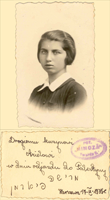Ariel Steps Into his Parent's Past in Poland
Poland Summer 1935
WhatsNew:
Release October 16, 2022
Yigal used to write short chapters and read them at various events in the nursing home where he lived in the last years of his life.
The large and interesting part of the chapters are part of his life history.
Few are translations or abridgments of facts related to general education.
Release Feb 23, 2020
Berek Szczekacz and Chana Szmidt
Berek Szczekacz and Chana Szmidt had 12 children. Searching for Birth, Marriage, Death records (BMD) brings us occasionally to meet living family members. I admit, getting to know new blood related family members is the most exciting part of doing genealogy. Lately I met Yoram Shachar, one of Berek and Chana’s great, greatgrandchild about whom I haven’t heard until Dec 15, 2019. The meeting has prompted me to create pages for the descendants of Berek Szczekacz, our mutual great, great grandfather. The released page will introduce you to the 12 children and to their children. Currently there are only two documented stories, about Layzer Ludwig Szczekacz and about Frajdla Szczekacz. The stories about Yoram Shachar, Samuel Szczekacz (The artist, Shmuel Tzur), the many Shakter’s descendants and others will follow soon.
Release Nov 9, 2019
Yosef Kaluzynski and Chana nee Sznajderman
Release Jan 6, 2018
Fajgla Kaluzynski and Wolf Szperling

The Holocaust Had no Mercy for the Szperling Family
Stories and Photos
Release June 26, 20
A Telephone call from Australia to Californiaswept Jane and me into a research in the Czech Republic. Several families appeared for a moment and then disappeared during the Holocaust. Very few suvivors, many Yad Vashem testimony pages and research in the Czech Republic declared Jane, Dov Kuflik, his sister, Idit, and the five grandchildren of Josef Arieli, my self included, are 3rd cousins. Jane, Dov and his sister, Idit, are 2nd cousins.
Dawid Borejdo Sznajderman
The following story is about Dawid Sznajderman, the son of Abram Moshe Sznajderman and Ajdla Koenigsberg, who survived the tumultuous time of WWII.
Marek Kaluzynski was son of my great grandfather, Abram Kaluzynski, and his second wife, Chaja Dzialoszynska.
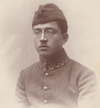
Marek’s mother, Chaja, died around 1912 in Czestochowa, leaving his father with five young children;
the youngest, Sara, was two years old. Marek was fourteen years old.
Release History
Important Links
Read the Beautiful translation by Jerrold Landau
Connect with Czestochowers all over the wold.
The World Society of
Czestochowa Jews
And Their Descendants
Family History
Memories, like sand stones
Slowly, a grain follows a grain,
Erode, crumble, and vanish.
Sea waves and wind
Sweep them away
Hurry
Listen to the voices
Collect the words,
The names, the episodes, the moments…
Carve and seal them
In a meticulously crafted pendant
Close to your heart
Allow them to live forever.
Let Us Start With Basic Steps:
Write down everything you know about yourself and about your family:
- Full names
- Date of Birth, Marriage and Death
- Where these events occured
- Talk to your grandparents, parents, uncles and aunts
- Write down family anecdotes
- Scan family photos
- Scan Family documents
"The present is the loom
A simple frame upon which we spin the threads of the past
To create the wool, the future of our life time"
Binyamin Mendelsztam
|
- 1 - PROLOG Today it is popular to research one’s family roots. We research archives in countries we have never lived in. We write about periods that passed away decades before we were born. We try to recreate the life of people who have passed away. We search for documents and photos that may have been damaged or destroyed, and try to uncover memories that have faded away or vanished altogether. We strive to get the most out of every record, photo and tale to create the most detailed, comprehensive life history of our families. The memories and stories about our parents, grandparents, and extended families are part of our heritage, and we all attempt to pass our version of history along. Different stories, of course, may exist, and naturally, all of us believe that our version of the history is the actual truth. We will not deny other stories, or challenge them. We can only write down and document those old memories, merge the stories, and open a window to that time. That time is when our ancestors lived in the old country, in my own family case, Belarus, Poland and Israel, before it became an independent state, the Mandate Palestine, long before we were born or able to understand our ancestors’ conversations. |
- 2 - Numerous family stories pop up. One story triggers another story and they start a link list of stories. Even though history always follows dates and clear direction, memories comes in chaos, they do not have a clear direction in time. Therefore, it happened that a small pile of tiny photos intrigued me to tell you about my father’s journey from Israel to Poland during the summer of 1935. As we shall see the photos, the identification of people and places, the remaining mysteries and the participation of family members in the process of recreating the story brought up many more stories that are linked to the current story. My father, Ariel Arieli, passed away in 1978 at the age of 59. More than twenty years later, I started to research the family history in-depth. I am sure he would have loved the project. After all, Ariel was an extrovert. He always shared his experience with everyone who was willing to listen. Nevertheless, I do not remember him ever bringing up stories about his journey to Poland. We knew the trip had taken place, but we hardly knew anything about the trip itself. |
- 3 - At the end of WWII, Holocaust survivors did not open their heart and did not share their traumas. Relatives of people who perished in Europe also avoided expressing their emotions in public. There was a silence in an attempt to hide the painful, horrendous memories about the Holocaust. Maybe my Ariel’s silence about his trip, like his father’s, was part of the general public behavior in Israel after the Holocaust. |
- 4 - I assume that the answers to all these questions are positive. Recently, I asked Ariel’s brother, Yigal, who is now 97 years old about my father’s trip. My uncle’s memory is still as sharp and clear as ever. “Do you remember any of my father’s stories from the trip?” I wanted to know. The people and the places in the tiny photos kept bugging me and I decided to recreate the story of my father’s experience in Poland. My sister Ora and I did manage to find additional photos taken in Poland during Ariel’s journey. Some photos have a note and even a date on the back. My sister, Ora, who has the memory and the eye of an artist, remembers a few details from long ago. Therefore, we sat down together for hours, she in Boston and I in Palo Alto, linked over the phone, and we slowly concocted, from few clues, the story of our 16-year-old father travelling all by himself to Poland, to meet Kaluzynskies, Sznajedremans, Sztatlers and other close relatives. |
|
- 4 - A blank page on the computer screen. The keyboard is ready but my hands are not typing. The unknowns, the unanswered questions hold up the flow of the story. Who were the people in the photos? How are they related to us? Did Ariel write letters during his stay in Poland to his parents or to his girlfriend, my mother Chaya? Maybe, but we did not find any letters. Did he keep a diary? I doubt it. Did my grandfather, Yosef Kaluzynski got letters from his relatives about meeting his son Ariel in Poland? Did they reply? My sisters and I never found any such letters. |
- 5 - Before WWII, very few people emigrated from Poland to Israel. My grandparents immigrated to Israel at the beginning of the twentieth century. They left their families while still in their teens. Letters sent through the post were their only means of communication. The prospects for reuniting the family in the near future were very dim. I can only imagine our grandparents yearning to introduce their son to their brothers, sisters, and cousins who lived far away in the old country. I tried to imagine Ariel’s expectations before he left for Poland. Who were the relatives he was about to meet there? |
|
- 6 - My grandfather, Yosef KALUZYNSKI, was born and lived in Czestochowa, Poland, before immigrating to Israel. In 1935, his father, Abraham KALUZYNSKI, and some of his siblings still lived in Czestochowa: In this point of my own exploration, I was not yet aware that other members of the Kaluzynski family existed, but came to discover that they also lived in Czestochowa, Radomsko, Piotrkow and other shtetls. |
- 7 - My grandmother, Hanna Arieli Sznajderman, was born in Zawiercie. Both of her parents, Eliezer Sznajderman and Eygda nee Sztatler passed away before 1935. Some of her brothers and sisters immigrated to Israel at the beginning of the twentieth century. Her eldest brother, Abraham Moshe SZNAJDERMAN, stayed behind in Zawiercie. A careful study of Ariel’s photos provides a snapshot of Abraham Moshe’s children when Ariel visited them in Zawiercie. The surname of my great grandmother Eygda was SZTATLER. The story will present us with a vague idea of the whereabouts of the SZTATLERS at the time of Ariel’s visit. |
- 8 - Ariel started his journey early in July 1935. Today, as we look back, we know that five years later, almost all these relatives perished in the streets or in concentration camps at the hands of the Nazis. In 1935there were already growing tensions between the democratic and fascist states in Europe. A small pile of miniature photos shed light on Ariel’s trip. His first stop was Athens, Greece. The label on the back of a photo tells us “A Holy place, Athens. July 15, 1935”. I can imagine the spirit of my adventurous father, his own first trip outside of Israel, walking among the sites of Greek mythology. In 1966, I flew to Athens. It was my first trip out of Israel, and as I recall, my excitement was immeasurable. My father helped me to organize the trip, but never mentioned his own visit to Athens twenty-five years before. |
- 9 -
I wish I knew the route of his trip from Greece to Poland. Who organized his trip? Did he travel by train from Greece through Germany or through the Czech Republic and then to Poland? |
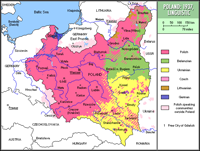 Poland Linguistic Map 1937
Poland Linguistic Map 1937This is a file from the Wikimedia Commons. |
|
- 10 - CZESTOCHOWA Another photo dated July 3, 1935 documents Ariel’s arrival at Czestochowa, Poland. The dates, as you see, should be treated with some suspicion as slight discrepancies evident. On the back of the photo, my father’s unique handwriting tells us that his uncle Henrik Kaluzynski with his wife Chana (Andreia Hellman) and Mrs. Leibel came to meet him at the Czestochowa Train station. The photo, however, depicts a boulevard, not a train station. Czestochowa does have a Druga (Boulevard), the Aleja Najswietszej Marii Panny. The wide boulevard extends from the former Jewish quarter and ends at the entrance to the famous Jasna Góra monastery. Henrik Kaluzynski and his wife, Hanna, are dressed elegantly as they stand in front of the photographer. Henrik remind us of our grandfather; in fact, one can almost mistake him for grandfather Yosef. Was Ariel the photographer? |
- 11 -
Meeting Ariel at Czestochowa Train Station |
- 12 - 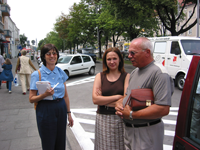
In 2002 Ora, my sister, Amos, my husband, and I visited Czestochowa as you can see in the photo below. The photo background is the same-Aleja Najswietszej Marii Panny. I am on the left, with Andrej Kaluzynski and his daughter, who are not Jewish. I will tell their story separately. |
- 13 - I was curious to see a photo of the Czestochowa railway station in 1935. I wanted to experience the sight my father saw when he stepped out of the train in Czestochowa. I sent a message to my friend Tomek Wisiniewski with my request. Tomek responded the next day with a photo of the old railway station and some examples of the railway tickets. |
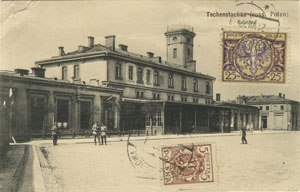 1935 - Czestochowa Railway Station
1935 - Czestochowa Railway Station |
- 14 -
About a month later on my father's visit, |
- 15 - Look at my father, Ariel, with the light colored suit-a handsome, 16-year-old boy. I wish I knew who made the suit for him and how much effort went into its making. His parents probably worked hard and saved every penny to allow him to make the trip. Ariel was only sixteen years old but was already engaged in a serious relationship with Chaya Lifshitz, my mother, who awaited him in Schunat Montefiori, Tel Aviv. I have practical questions on my mind, for example, about Ariel’s suit. I must admit that I have more questions along the same lines: What was the name of the boat he took from Tel Aviv or Haifa? There are no clear answers. One more question keeps looming all over the story. What was the reason for Ariel’s trip to Poland? Did my grandparents dream about sending their son to visit their family in Poland? Was the restless Ariel looking for an opportunity to leave the nest for a couple of months? Again, there is no clear answer. |
- 16 - Let us return to our family photo in Czestochowa: Henryk, who looks like our grandfather, his wife Chana, Stefa and Ariel. Stefa and Ariel are first cousins. I have the notion that young girls always adore their older cousins. A big, vivid smile lights up Stefa's face. In a separate photo, the two cousins are marching like soldiers along the street. Stefa's shining face hints of her pleasure in the company of her young guest. This photo is my favorite. There is a special sweetness and charm in the face of the young, innocent Stefa. 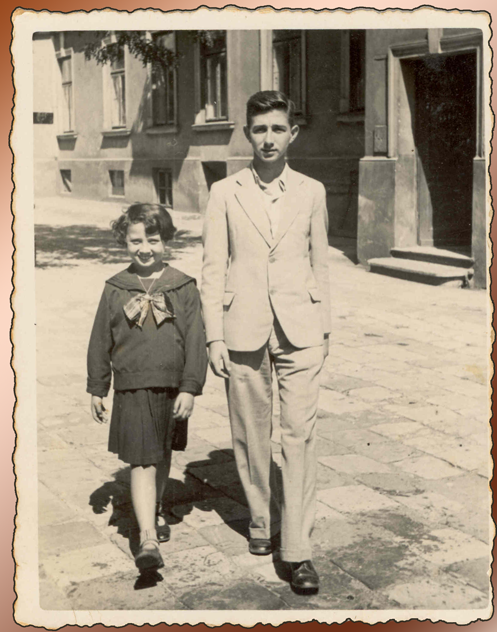
|
|
- 17 - Ariel stayed in Czestochowa at the home of his uncle Henrik and his family. We get a glimpse into their small apartment. In the photo: Henrik, Andrea and Unknown Women, Stefa is standing in front. 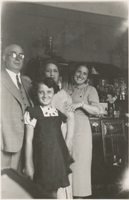
|
- 18 - In September 1935, the family posed for another photo. If we ignore the dates on the back of the photos, we would have thought that all of them were taken on the same date. Henryk, Chana and Stefa were always dressed up in the same clothes and the Leibel family was present next to the Kaluzynski family in every photo. 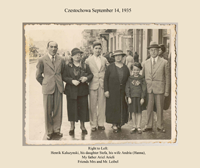
|
- 19 - Who are Mr. and Mrs. Leibel? Is Leibel a surname or a given name? I had never heard the name in any conversation at my grandparents' home. It appears that they were close enough relatives to participate in the occasion of Ariel's visit. During this period, taking a photo was a special event and Ariel's visit was most certainly a special event. The Leibel family members appear in several photos. In order to try to learn more about the Leibel family, I looked carefully at some photos that I could not previously link to the story. |
|
- 20 - A portrait photo dedicated to my father with documentation on its back offered the initial key to the solution of the identity of the Leibel family. The name of the handsome girl is Mariszia. She writes on the back of the photo: “To Ariel my cousin on returning back to Palestine.”
|
- 21 - The same girl, Mariszia, and an unknown man stood for a photo in front of a solid, brick building. I scrutinized the photo closely and I examined Mr. Leibel in previous photos. There is almost no doubt that Mr. Leibel was standing beside Mariszia, and so he is most likely her father.
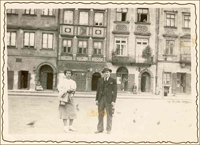
|
- 22 - Upon observing the other photos carefully, I can see that Mariszia appears repeatedly. Mariszia is second on the left in the next family photo. The other people are unknown
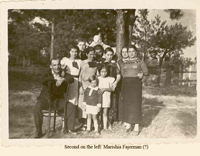
|
|
- 23 - 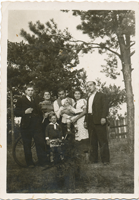 Marisia on the right and unknown Family members
Marisia on the right and unknown Family members |
- 24 - 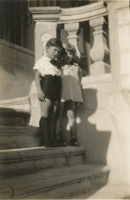 The young handsome boy appears in another photo
The young handsome boy appears in another photo |
- 25 - To further decipher the story behind the photos is very challanging. Is Mr. Leibel or his wife a member of the Kaluzynski family? Is Mariszia their daughter? I have no idea about the other people in the photos. Were they murdered in the Holocaust? Did any of them survive? Are any of them or their descendants still alive? Who else in the extended family can identify them? In a separate detective story, I will unfold the story of how I solved some of the mysteries suggested by the above photos and how I linked Mariszia and her parents, the Fajermans, to the Kaluzynski family tree. |
|
- 26 - ZAWIERCIE More questions cross my mind when I write about my father’s visit in Poland: |
- 27 - There were more living siblings of Avraham Kaluzynski in Czestochowa and Radomsko in 1935, among them were Laiser Kaluzynski and his family, Udla Librowicz née Kaluzynski and her family. The photos give no hints of Ariel meeting them. One of the photos however, does, suggest the possibility of a visit to Olsztyn in northern Poland. Olsztyn might be the place where some of the Librowicz family lived. It is not a photo of relatives, but of a historical site. |
|
- 28 - More unidentified photos are scattered across my computer screen like puzzle pieces. I am trying to fit them together. |
- 29 - 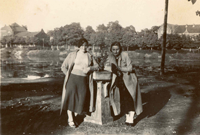
|
- 30 - 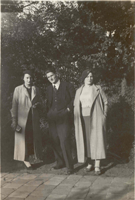
|
|
- 31 - The next photo reveals the view of a room, sewing machine, a massive, ornate closet with a sculpture on top of it. Next to the closet is a decorated window. A small chandelier hangs from the ceiling, and the walls are decorated with a delicate, border design. A small picture hangs on the wall behind the women. A door opens, perhaps to the kitchen and there we can guess is the entrance door with a mezuzah at the side. The daughter, Guta, in the black dress whom we saw above is standing behind an older woman. 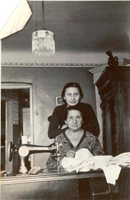
|
- 32 - The young woman in the light-colored blouse stands next to a brick house: 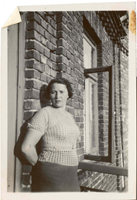
|
- 33 - The next photo (below) provided the connection among the previous three photos. In the photo below, my second cousin, Tolek Borejdo, recognized his grandfather Abraham Moshe as the man standing next to the same brick house as the young woman in the light colored blouse. Abraham Moshe was the brother of my grandmother, Chana Sznajderman. 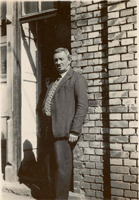 Abram Moshe Sznajderman
Abram Moshe Sznajderman |
|
- 34 - The name of the town where Abraham Moshe lived is hard to pin down. The photo does not have any information on the back. Birth, marriage and death records tell us that Abraham Moshe was born in Pilica in 1874 and married Adela Koenigsberg, , in Zarki in 1897. Adela is the woman next to the sewing machine in the previous photo. Abraham died in Zawiercie in 1938. In 2002, I visited Zawiercie and found his grave next to his parents’ grave. According to the Zawiercie Business Directory (1926-1929), he had a tobacco store in Zawiercie. Adela, his wife, did not survive the Holocaust. She was murdered in Auschwitz. Abraham Moshe and Adela had four children: Dawid, the eldest, born in 1897, Judith, Guta and Maurice. The two young women in the above photos is Guta and Unknown woman and the young man standing between them is also unknown. Currently, I have no way to confirm that my identification of these three people is correct. In 1935 the eldest son Dawid, was already married to Fela Perleman and had a daughter Irene. Fela was born in Bedzin as was their daughter. Fela and Irene did not survive the Holocaust. They were shot to death on a street corner in Katowicz. Dawid’s survival story is long will appear later in the family saga. |
- 35 - Judith and Guta immigrated to Israel before WWII. Later Judith immigrated to Mexico. As a result of the project I became good friend with Adela, Judith's granddaughter. Guta returned to Poland and did not survive the Holocaust. Maurice immigrated to France and survived the Holocaust. Today his granddaughters and I are friends on Facebook. The photos continue to tell us that the Sznajderman family members gathered to meet Ariel and spent some time with him. They invited him to spend a few summer days in Zakopane, a picturesque town on the southern border of Poland, one of Poland's most popular vacation spots back then as well as today. They stayed in Poronin, a small village close to Zakopane, where the residents still keep their old customs and traditions. 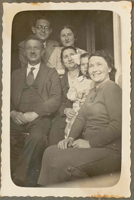 Abram Moshe And his Family
Abram Moshe And his Family |
- 36 - 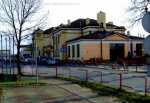
Zawiercie Train Station |
|
- 37 - 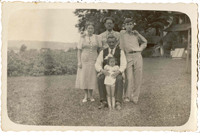 Abram Moshe Sznajderman and his grand daughter Irene
Abram Moshe Sznajderman and his grand daughter IreneIrene's parents David Sznajderman and Fela nee Perlmuter Standing on the right Ariel Arieli |
- 38 - 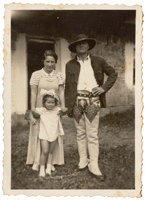 Poronin - Zakopane on August 1, 1935
Poronin - Zakopane on August 1, 1935Maria Perlman, Fela's sister, Irene and one of the Zakopane's folkpeople |
- 39 - 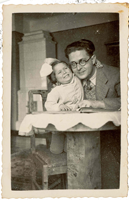 Dawid Sznajderman
Dawid Sznajdermanand his daughter Irene |
|
- 40 - Ariel visited Zawiercie and paid his respects to the graves of his grandparents, Eygda and Eliezer. 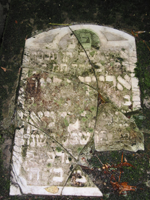 Eliezer Rosen Sznajderman
Eliezer Rosen SznajdermanBorn: 04 Feb, 1852, Pilica Died: About 1923, Zawiercie |
- 41 - In 2002, Ora and I stopped over in Zawiercie for a short day. We walked through the Zawiercie cemetery and found our great grandparents’ graves, their son Abram Moshe’s grave and the graves of two other Sznajderman Family members. 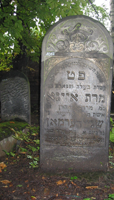 Eygda Sznajderman nee Sztatler
Eygda Sznajderman nee SztatlerBorn: About 1847 Died: About 1913, Zawiercie |
- 42 - Our experience of standing next to the family graves in Zawiercie inspired and affected Ora’s art. Since then, she has depicted her thoughts and emotions about the family history, as well as the Jewish sorrow in Eastern Europe, in her works of art. She designed a set of enamel art pieces of our great grandmother’s portrait, her grave and details of her kitchen.
 Abram Moshe Sznajderman
Abram Moshe SznajdermanBorn: 3 Jan 1874, Pilica Died: 26 Feb 1938 Zawiercie |
|
- 43 - OLKUSZ One of the photos in this small collection has the note “On the road to Olkusz” written at the bottom. At our extended family gatherings, we heard the names of the towns such as Zawiercie, Czestochowa, and Bedzin, but I do not recall the shtetl of Olkusz ever being mentioned. The photo below presents a group of young and old people riding in a horse drawn-wagon. I did not recognize any of them.
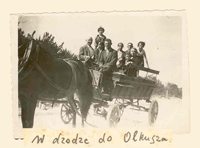 On theRoad to Olkusz
On theRoad to Olkusz |
- 44 - Before I delved deeply into this project to discover my family’s roots, I did not know about the shtetl of Olkusz. Through my search for our ancestors, I found out that the maiden name of our great grandmother, Eygda Sznajderman, was Sztatler. I remembered the name Sztatler coming up in conversations at my grandparents’ home. I interviewed many Sztatler family members who survived the Holocaust. In reviewing the information I have collected in the last several years, I found out that the Sztatler Family had resided in Olkusz since at least 1816. Eygda Sznajderman née Sztatler was born and married in Olkusz. Between the years 1907 to 1942, 41 members of the Sztatler family were born, married and died in Olkusz. I do not know whether the Sztatlers in Olkusz were in close contact with the family in Israel, or perhaps Abraham Moshe Sznajderman told Ariel to visit the family in Olkusz. As we see from the photo, Ariel took the time to visit the Sztatler family in Olkusz. I wish I could identify the members of the group. In a separate essay, I will publish the birth, marriage, and death records of the Sztatler family in Olkusz and I will try to show their relation to our family. |
- 45 - In 2002 we visited Olkusz, we walked through the town square and visited the Olkusz Registery Office but there was no sign for Olkusz Synagogue and the cemetery was badly preserved. I found in the site www.sztetl.org.pl a photo of Olkusz Synagogue.The Synagogue was devastated during the Holocaust. It was demolished in 1950. 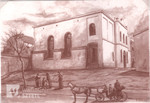
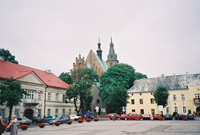 2002 - Olkusz Square
2002 - Olkusz Square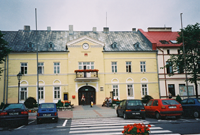 2002 - Olkusz Regisry Office
2002 - Olkusz Regisry Office |
|
- 46 - PIOTROKOW TRYB The story does not end with the last photo. There is at least one more chapter with no photos. In 1935, the number of photographs one could take on a trip depended on a number of factors: the photos had to fit on rolls of film, so the number of rolls one took on a trip might limit the photos produced, and furthermore, the photos had to be successfully developed. We can assume that many of these limitations explain the absence of photographic documentation in some parts of Ariel's journey in Poland. |
- 47 - 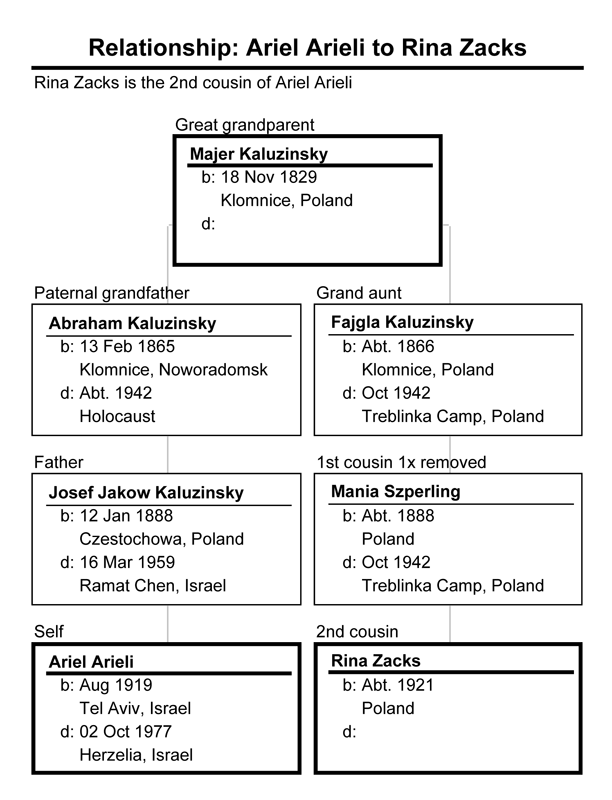
|
|
- 48 - Ariel and Rina were second cousins. Ariel’s grandfather Abraham and Rina’s grandmother were siblings. Rina immigrated to Israel in 1945 and since then she was always in touch with my father, Ariel. Ariel’s death in 1978 ended close connection with his extended family, but fortunately my father introduced me to Rina Irmay when I studied in the Technion. I lived next to the Irmay family on a small, green alley in Neveh Sha’anan during my first year in the Technion and we became very close friends. Rina knows about my genealogy research and she is an inexhaustible source of information. She herself, with her infinite courage and strength, survived the Holocaust. I will tell her remarkable story in a separate chapter. |
- 49 - When I became busy with the work of recovering the story of my father’s trip, I called Rina early one morning. “Did you meet my father in 1935 during his visit to Poland?” |
- 50 - When I became busy with the work of recovering the story of my father’s trip, I called Rina early one morning. “Did you meet my father in 1935 during his visit to Poland?” “How did Ariel know about you?” I asked. |
|
- 52 - Slowly I reconstructed my memories of Sabina. Sabina’s maiden name was Szperling, and her married name was Ankilewicz. The Ankilewicz family had a florist shop on Allenby Street in Tel Aviv, not far from our family’s printing press. The two families, Kaluzynski and Ankilewicz, were close. The Ankilewiczes visited my grandparents frequently. I do not remember whether they brought flowers when they visited. At the time, I was familiar with members of the Ankilewicz family, but I did not know the exact relationship. Today I know that Sabina was my grandfather Yosef’s first cousin, Rina’s aunt. I assume that my grandfather consulted Sabina before Ariel went on his trip, and that is how Piotrkow made its way into his itinerary. As I said there are no photos of Ariel in Piotrokow, but following photos from Rina’s album, will introduce you to the Szperling faces that many of you have never met before: |
- 53 - 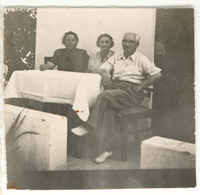
On the Left Sabina Ankelevitz nee Szperling with Chana and Yosef Arieli 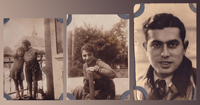
Left to Right: Rina (survived the Holocaust) Romek (was killed on the first day of the war in Piotrokow), Lunia (disappeared in Russia) and Nolek (immigrated to Israel before WWII) |
|
- 54 - EPILOG Poland, at the end of 1935. It is already November and the weather is cold. How long did Ariel stay in Poland? Did he leave in September? Did Stefa send him the photo later by mail? |
- 55 - 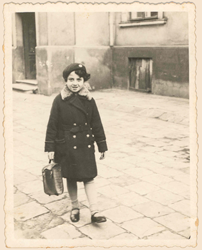
Czestochowa, 10 Nov 1935, Stefa Kaluzynski |
- 56 - 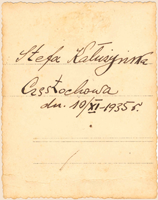
|
|
- 57 - The photos hide more than they reveal. We see faces, at moments when the family gathered with their guest, and also rare glimpses into their life in Europe. Nevertheless, these few momentos are dear to everyone in the family who left Poland before WWII or survived the Holocaust. My sisters remember that my father kept saying that he feels guilty for not encouraging the family in Poland to pack their belongings and immigrate to Israel. Ora's memories about our father's expressions of guilt go beyond his collective feelings. She remembers his telling her repeatedly about a young girl who was not home at the time of his departure. "I did not say goodbye to the young girl, and then a few years later she was murdered by the Nazis," Ariel said. Who is the young girl? Is she Stefa Kaluzynski, Mariszia Fajerman, Irene Sznajderman? |
- 58 - The following are names of some of the family members whom my father met during his journey and did not survive the Holocaust. I hope my story will keep them alive forever in the memory of my extended family. Abraham Kaluzynski Henrik, Chana née Helman and Stefa Kaluzynski Mania Gutman née Kaluzynski Stasiek Gutman Guta Blumenfrucht née Kaluzynski Jurek Blumenfrucht Staszek Blumenfrucht Marek Kaluzynski The Fajerman Family Adela Sznajderman Fela Sznajderman née Perlman and her daughter Irene Fajga Szperling née Kaluzynski Idel Zaks Manis Zacks née Szperling Romek Zaks Lunia Zaks The Sztatler Family members With this sad memorial the story of my father's journey to an end, but it opens the way to a chain of stories that can continue to assemble from memories, photos and archives. |
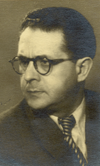
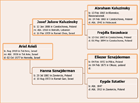
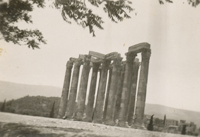
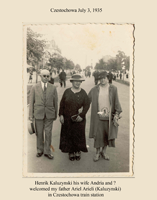 Czestochowa, Poland - July 3, 1935
Czestochowa, Poland - July 3, 1935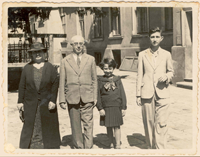 Czestochowa 1935:
Czestochowa 1935: